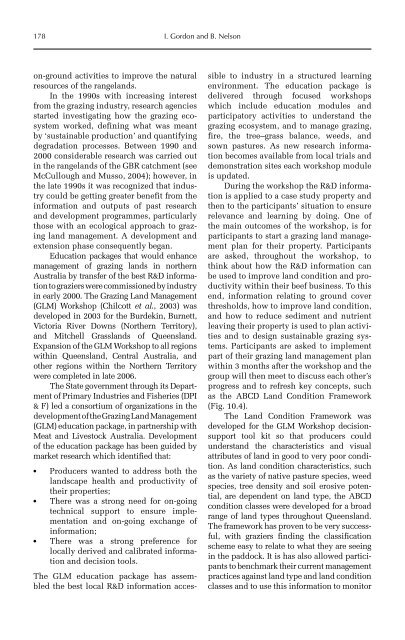Redesigning Animal Agriculture
Redesigning Animal Agriculture
Redesigning Animal Agriculture
Create successful ePaper yourself
Turn your PDF publications into a flip-book with our unique Google optimized e-Paper software.
178 I. Gordon and B. Nelson<br />
on-ground activities to improve the natural<br />
resources of the rangelands.<br />
In the 1990s with increasing interest<br />
from the grazing industry, research agencies<br />
started investigating how the grazing ecosystem<br />
worked, defining what was meant<br />
by ‘sustainable production’ and quantifying<br />
degradation processes. Between 1990 and<br />
2000 considerable research was carried out<br />
in the rangelands of the GBR catchment (see<br />
McCullough and Musso, 2004); however, in<br />
the late 1990s it was recognized that industry<br />
could be getting greater benefit from the<br />
information and outputs of past research<br />
and development programmes, particularly<br />
those with an ecological approach to grazing<br />
land management. A development and<br />
extension phase consequently began.<br />
Education packages that would enhance<br />
management of grazing lands in northern<br />
Australia by transfer of the best R&D information<br />
to graziers were commissioned by industry<br />
in early 2000. The Grazing Land Management<br />
(GLM) Workshop (Chilcott et al., 2003) was<br />
developed in 2003 for the Burdekin, Burnett,<br />
Victoria River Downs (Northern Territory),<br />
and Mitchell Grasslands of Queensland.<br />
Expansion of the GLM Workshop to all regions<br />
within Queensland, Central Australia, and<br />
other regions within the Northern Territory<br />
were completed in late 2006.<br />
The State government through its Department<br />
of Primary Industries and Fisheries (DPI<br />
& F) led a consortium of organizations in the<br />
development of the Grazing Land Management<br />
(GLM) education package, in partner ship with<br />
Meat and Livestock Australia. Development<br />
of the education package has been guided by<br />
market research which identified that:<br />
● Producers wanted to address both the<br />
landscape health and productivity of<br />
their properties;<br />
● There was a strong need for on-going<br />
technical support to ensure implementation<br />
and on-going exchange of<br />
information;<br />
● There was a strong preference for<br />
locally derived and calibrated information<br />
and decision tools.<br />
The GLM education package has assembled<br />
the best local R&D information acces-<br />
sible to industry in a structured learning<br />
environment. The education package is<br />
delivered through focused workshops<br />
which include education modules and<br />
participatory activities to understand the<br />
grazing ecosystem, and to manage grazing,<br />
fire, the tree–grass balance, weeds, and<br />
sown pastures. As new research information<br />
becomes available from local trials and<br />
demonstration sites each workshop module<br />
is updated.<br />
During the workshop the R&D information<br />
is applied to a case study property and<br />
then to the participants’ situation to ensure<br />
relevance and learning by doing. One of<br />
the main outcomes of the workshop, is for<br />
participants to start a grazing land management<br />
plan for their property. Participants<br />
are asked, throughout the workshop, to<br />
think about how the R&D information can<br />
be used to improve land condition and productivity<br />
within their beef business. To this<br />
end, information relating to ground cover<br />
thresholds, how to improve land condition,<br />
and how to reduce sediment and nutrient<br />
leaving their property is used to plan activities<br />
and to design sustainable grazing systems.<br />
Participants are asked to implement<br />
part of their grazing land management plan<br />
within 3 months after the workshop and the<br />
group will then meet to discuss each other’s<br />
progress and to refresh key concepts, such<br />
as the ABCD Land Condition Framework<br />
(Fig. 10.4).<br />
The Land Condition Framework was<br />
developed for the GLM Workshop decisionsupport<br />
tool kit so that producers could<br />
understand the characteristics and visual<br />
attributes of land in good to very poor condition.<br />
As land condition characteristics, such<br />
as the variety of native pasture species, weed<br />
species, tree density and soil erosive potential,<br />
are dependent on land type, the ABCD<br />
condition classes were developed for a broad<br />
range of land types throughout Queensland.<br />
The framework has proven to be very successful,<br />
with graziers finding the classification<br />
scheme easy to relate to what they are seeing<br />
in the paddock. It is has also allowed participants<br />
to benchmark their current management<br />
practices against land type and land condition<br />
classes and to use this information to monitor










